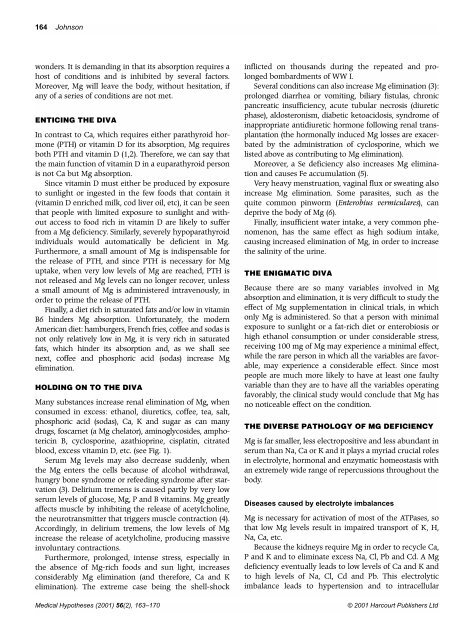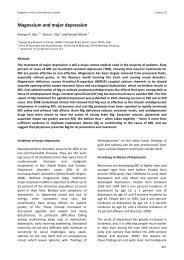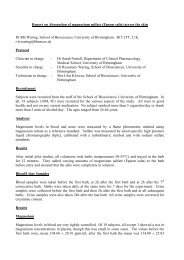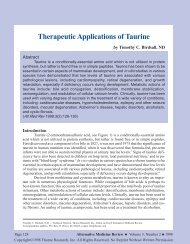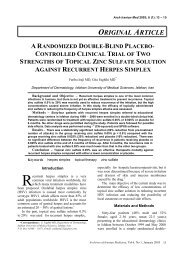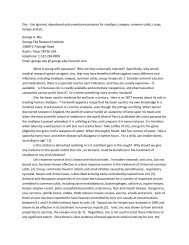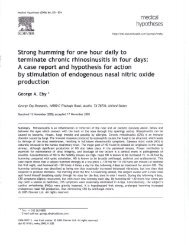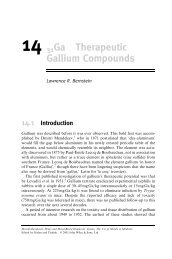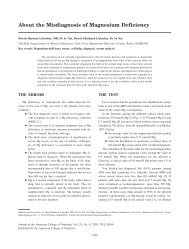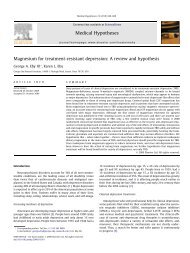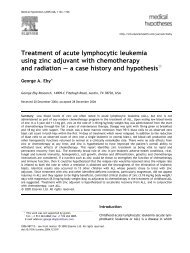The multifaceted and widespread pathology of magnesium deficiency
The multifaceted and widespread pathology of magnesium deficiency
The multifaceted and widespread pathology of magnesium deficiency
You also want an ePaper? Increase the reach of your titles
YUMPU automatically turns print PDFs into web optimized ePapers that Google loves.
164 Johnson<br />
wonders. It is dem<strong>and</strong>ing in that its absorption requires a<br />
host <strong>of</strong> conditions <strong>and</strong> is inhibited by several factors.<br />
Moreover, Mg will leave the body, without hesitation, if<br />
any <strong>of</strong> a series <strong>of</strong> conditions are not met.<br />
ENTICING THE DIVA<br />
In contrast to Ca, which requires either parathyroid hormone<br />
(PTH) or vitamin D for its absorption, Mg requires<br />
both PTH <strong>and</strong> vitamin D (1,2). <strong>The</strong>refore, we can say that<br />
the main function <strong>of</strong> vitamin D in a euparathyroid person<br />
is not Ca but Mg absorption.<br />
Since vitamin D must either be produced by exposure<br />
to sunlight or ingested in the few foods that contain it<br />
(vitamin D enriched milk, cod liver oil, etc), it can be seen<br />
that people with limited exposure to sunlight <strong>and</strong> without<br />
access to food rich in vitamin D are likely to suffer<br />
from a Mg <strong>deficiency</strong>. Similarly, severely hypoparathyroid<br />
individuals would automatically be deficient in Mg.<br />
Furthermore, a small amount <strong>of</strong> Mg is indispensable for<br />
the release <strong>of</strong> PTH, <strong>and</strong> since PTH is necessary for Mg<br />
uptake, when very low levels <strong>of</strong> Mg are reached, PTH is<br />
not released <strong>and</strong> Mg levels can no longer recover, unless<br />
a small amount <strong>of</strong> Mg is administered intravenously, in<br />
order to prime the release <strong>of</strong> PTH.<br />
Finally, a diet rich in saturated fats <strong>and</strong>/or low in vitamin<br />
B6 hinders Mg absorption. Unfortunately, the modern<br />
American diet: hamburgers, French fries, c<strong>of</strong>fee <strong>and</strong> sodas is<br />
not only relatively low in Mg, it is very rich in saturated<br />
fats, which hinder its absorption <strong>and</strong>, as we shall see<br />
next, c<strong>of</strong>fee <strong>and</strong> phosphoric acid (sodas) increase Mg<br />
elimination.<br />
HOLDING ON TO THE DIVA<br />
Many substances increase renal elimination <strong>of</strong> Mg, when<br />
consumed in excess: ethanol, diuretics, c<strong>of</strong>fee, tea, salt,<br />
phosphoric acid (sodas), Ca, K <strong>and</strong> sugar as can many<br />
drugs, foscarnet (a Mg chelator), aminoglycosides, amphotericin<br />
B, cyclosporine, azathioprine, cisplatin, citrated<br />
blood, excess vitamin D, etc. (see Fig. 1).<br />
Serum Mg levels may also decrease suddenly, when<br />
the Mg enters the cells because <strong>of</strong> alcohol withdrawal,<br />
hungry bone syndrome or refeeding syndrome after starvation<br />
(3). Delirium tremens is caused partly by very low<br />
serum levels <strong>of</strong> glucose, Mg, P <strong>and</strong> B vitamins. Mg greatly<br />
affects muscle by inhibiting the release <strong>of</strong> acetylcholine,<br />
the neurotransmitter that triggers muscle contraction (4).<br />
Accordingly, in delirium tremens, the low levels <strong>of</strong> Mg<br />
increase the release <strong>of</strong> acetylcholine, producing massive<br />
involuntary contractions.<br />
Furthermore, prolonged, intense stress, especially in<br />
the absence <strong>of</strong> Mg-rich foods <strong>and</strong> sun light, increases<br />
considerably Mg elimination (<strong>and</strong> therefore, Ca <strong>and</strong> K<br />
elimination). <strong>The</strong> extreme case being the shell-shock<br />
inflicted on thous<strong>and</strong>s during the repeated <strong>and</strong> prolonged<br />
bombardments <strong>of</strong> WW I.<br />
Several conditions can also increase Mg elimination (3):<br />
prolonged diarrhea or vomiting, biliary fistulas, chronic<br />
pancreatic insufficiency, acute tubular necrosis (diuretic<br />
phase), aldosteronism, diabetic ketoacidosis, syndrome <strong>of</strong><br />
inappropriate antidiuretic hormone following renal transplantation<br />
(the hormonally induced Mg losses are exacerbated<br />
by the administration <strong>of</strong> cyclosporine, which we<br />
listed above as contributing to Mg elimination).<br />
Moreover, a Se <strong>deficiency</strong> also increases Mg elimination<br />
<strong>and</strong> causes Fe accumulation (5).<br />
Very heavy menstruation, vaginal flux or sweating also<br />
increase Mg elimination. Some parasites, such as the<br />
quite common pinworm (Enterobius vermiculares), can<br />
deprive the body <strong>of</strong> Mg (6).<br />
Finally, insufficient water intake, a very common phenomenon,<br />
has the same effect as high sodium intake,<br />
causing increased elimination <strong>of</strong> Mg, in order to increase<br />
the salinity <strong>of</strong> the urine.<br />
THE ENIGMATIC DIVA<br />
Because there are so many variables involved in Mg<br />
absorption <strong>and</strong> elimination, it is very difficult to study the<br />
effect <strong>of</strong> Mg supplementation in clinical trials, in which<br />
only Mg is administered. So that a person with minimal<br />
exposure to sunlight or a fat-rich diet or enterobiosis or<br />
high ethanol consumption or under considerable stress,<br />
receiving 100 mg <strong>of</strong> Mg may experience a minimal effect,<br />
while the rare person in which all the variables are favorable,<br />
may experience a considerable effect. Since most<br />
people are much more likely to have at least one faulty<br />
variable than they are to have all the variables operating<br />
favorably, the clinical study would conclude that Mg has<br />
no noticeable effect on the condition.<br />
THE DIVERSE PATHOLOGY OF MG DEFICIENCY<br />
Mg is far smaller, less electropositive <strong>and</strong> less abundant in<br />
serum than Na, Ca or K <strong>and</strong> it plays a myriad crucial roles<br />
in electrolyte, hormonal <strong>and</strong> enzymatic homeostasis with<br />
an extremely wide range <strong>of</strong> repercussions throughout the<br />
body.<br />
Diseases caused by electrolyte imbalances<br />
Mg is necessary for activation <strong>of</strong> most <strong>of</strong> the ATPases, so<br />
that low Mg levels result in impaired transport <strong>of</strong> K, H,<br />
Na, Ca, etc.<br />
Because the kidneys require Mg in order to recycle Ca,<br />
P <strong>and</strong> K <strong>and</strong> to eliminate excess Na, Cl, Pb <strong>and</strong> Cd. A Mg<br />
<strong>deficiency</strong> eventually leads to low levels <strong>of</strong> Ca <strong>and</strong> K <strong>and</strong><br />
to high levels <strong>of</strong> Na, Cl, Cd <strong>and</strong> Pb. This electrolytic<br />
imbalance leads to hypertension <strong>and</strong> to intracellular<br />
Medical Hypotheses (2001) 56(2), 163–170 © 2001 Harcourt Publishers Ltd


